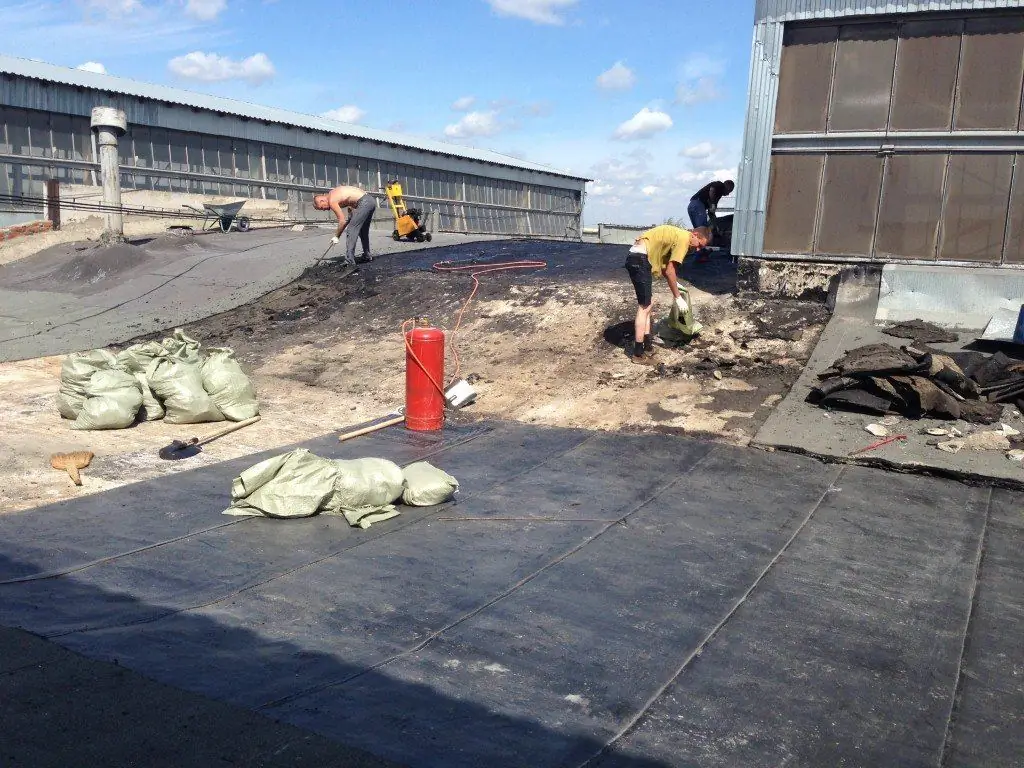
Table of contents:
- Author Bailey Albertson [email protected].
- Public 2024-01-17 22:26.
- Last modified 2025-06-01 07:32.
Repair of overlaid roof, technology and stages of implementation

The device of a soft roof by fusion is the least expensive option for flat and low-slope roofs. When using the right material, such roofs last up to 15 years, but they also require constant monitoring so that violations of the layer surface are detected in time. Even minor damage needs prompt repair to maintain the performance of the roof covering.
Content
-
1 How to repair a roof made of deposited materials
- 1.1 Photo gallery: elimination of various defects on a soft roof
- 1.2 Typical defects of a soft roof
- 1.3 Local repair of the roof: how to eliminate local mechanical damage
- 1.4 Correcting coating blisters
- 1.5 Elimination of the network of cracks
- 1.6 Bonding of the detached layer
- 1.7 Peeling of the sheet at the points of abutment to the vertical surface
- 2 Tool for work
-
3 Technology for repairing a roof made of deposited materials
- 3.1 Video: Do-it-yourself garage roofing update
- 3.2 Video: step-by-step execution of self-laying soft roof
-
4 Causes of damage to the soft roof
4.1 Video: the principle of correct web fusion
How to repair a roof made of deposited materials
As a result of long-term operation, the soft roofing becomes unusable and ceases to protect the roof from leaks. Then, depending on the degree of damage to the roof, a decision is made to replace the entire cover or conduct a local repair of damaged areas.
Photo gallery: elimination of various defects on a soft roof
-

Installing a new coating over the old - Fusing a new layer will greatly extend the life of the roof
-

Replacement of torn cover - In place of the torn sheet, a new piece is glued, cut to the desired size
-

Replacing the coating with a new one - First, the old coating is removed, and then a new layer of soft roof is applied
-

Roof defect at the abutment -
To solve the problem of delamination at the junction, new sheets are brought onto a vertical surface, bent inward and reinforced with a rail
If 40% of the surface is destroyed, then a complete roof renovation is done: the old coating is removed and a new one is covered.

The old covering is cut into pieces with a roof cutter
Preparatory repair work is carried out in dry, calm weather in the following order:
-
Removing the old coating - it is removed completely up to the concrete screed: with the help of a roof cutter, it is cut into pieces that are convenient for transportation, and peels off with an ax from the roof itself.

Dismantling the old roof The old covering is removed by removing the entire roofing cake.
-
Inspection of the cleaned surface to identify screed defects - the cracks are cleared, the destroyed mass is removed by blowing (compressed air), the pits are sealed with sand-cement mortar. Tool potholes are eliminated in the same way.

Roof screed When installing the screed, it is necessary to ensure that it is even and smooth
- Cleaning the surface from debris and dust.
- Primer with a special bitumen-based compound.
After preparing the roof, a new roof is laid in accordance with the requirements of the technology.
Typical defects of a soft roof
Common injuries include the following:
-
cracking of the surface layer, sagging of the mass of bitumen, the appearance of folding on the surface of the roof;

Crack in the roofing layer A small crack tears the entire length of the roof layer over time, if not noticed in time
-
peeling of the edges or joints of the roofing cake;

Delamination of joints Delamination of the joint can only be detected by close examination
-
the formation of cavities filled with air or water;

Local swelling of the roof layer Localized swelling of the roof layer is easy to correct when detected initially and is small
-
the appearance of a network of cracks (the so-called destruction from solar radiation);

Coating cracking Roofing cracking occurs in direct sunlight
-
loss of a protective layer in the form of sprinkling, defects in the coating from ice pressure in winter, or the presence of mechanical damage obtained during the removal of snow from the roof.

Cleaning the roof from snow Cleaning the roof from snow is often carried out with violations, without taking into account the structure of the roofing material.
Therefore, it is necessary to clean such roofs in winter only with wooden or plastic shovels.
Local repair of the roof: how to eliminate local mechanical damage
Defects such as small cracks, punctures or small cracks can be repaired. Its size should exceed the area of the defect by 10-15 cm from all edges. The elimination procedure is as follows:
- Clean the place of repair from debris and dust.
- Warm up the surface to be repaired with a burner until the bitumen softens and drown the protective layer (sprinkling) in it using a special roller.
- Cut the patch to the desired size.
-
Remove the protective film from the inner surface of the patch, warm up the plane with a burner and apply to the place of damage. Roll the patch thoroughly with a roller. A protrusion of molten bitumen should form around the patch at a distance of up to two centimeters from its edges. After the bitumen has cooled down, check the tightness of the bond with a spatula in places where the protrusion has not formed.

Roof patch Bonding a patch in place of a crack is the fastest and easiest way to fix a defect
Correcting coating blisters
The cause of blistering is temperature fluctuations. In the hot season, the difference between day and night temperatures reaches 70-80 degrees. This leads to an increase in the volume of air under the roof and intense evaporation of moisture from the roofing carpet.
How to eliminate coating swelling:
- The place of the defect is cut with an “envelope”.
- The edges are folded outwards and pressed against heavy objects.
- The exposed area is dried to remove moisture from the concrete slab.
- The surface is cleaned of contamination and treated with a primer (the rules for using the primer are indicated on the package).
-
The bent edges are heated to the required temperature with a gas burner, placed in the old place and carefully rolled with a roller.

Warming up the corners of the surface swelling In some cases, mastic is additionally used to glue corners.
- The outer surface of the damage is also heated up and a protective layer (sprinkling) is rolled with a roller. It is important that the bitumen of the top layer protrudes outward, creating conditions for the patch to adhere.
- A patch is cut out to a size that exceeds the damage by 10-15 cm. If necessary for a given location, the corners are rounded off.
-
The patch is applied, folded back in half, its lower layer is warmed up. Then it is glued and rolled tightly with a roller until an influx of bitumen is formed along the edges.

Repair scheme for bulges and cracks on a soft roof If water does not accumulate in the crack, then it is not opened, but a patch is immediately glued
Elimination of a network of cracks
Cracking of the web occurs due to the loss of a layer of protective dressing on the film. This is usually due to material defects.
But cracks appear on any bitumen material when the surface is heated in the summer, because the temperature on it can exceed 100 degrees. The second reason for cracking is the formation of puddles on the roof with an incorrect slope for the drain or when the drain funnel is clogged.

Clogged roof drainage leads to rapid delamination and destruction of the roof covering
Repair of a section with a network of cracks is carried out with standard bituminous mastic:
- The area is cleaned of debris, the surface is blown with compressed air: this is how the internal cavities of the cracks are cleaned and the poorly adhered flakes of the old coating are torn off.
-
A layer of standard mastic is applied: at least 2 mm thick over the old layer.

Sealing a network of cracks with mastic A small area of roofing with a network of cracks is easier to repair by pouring bitumen in two layers
- Fresh bituminous mastic is sprinkled with marble or granite chips (a fraction of 2-5 mm is used, after sifting it is thoroughly washed and dried). The mastic is applied in two layers. You can also use silver paint for the protective coating. It is applied after the fresh layer of mastic has completely hardened.
- After applying the first layer of mastic, a reinforcing layer of fiberglass or polyester mesh can be installed. The size of such a patch should protrude 10-15 centimeters beyond the edges of the damaged area.
Gluing the torn off layer
The edge of the roll coating layer may come off due to a violation of the laying technology: either the roof surface was poorly cleaned before coating, or it was not primed with a primer.

The result of poor preparation of the base leads to poor-quality gluing of the joints.
The elimination of this defect is carried out according to the general technology:
- The detached web is lifted and wrapped.
- In the opened space of the base, the remains of bitumen are carefully knocked down.
- The surface is primed with a primer or specially prepared bituminous mastic (it is diluted with gasoline in a ratio of 3: 1).
- The canvas is put in place, warmed up with a burner, and rolled with a roller.
-
If there was also a gap in the canvas, then a patch of a strip 20-25 cm wide is additionally applied over it.

Applying an additional patch strip Applying a patch strip will additionally strengthen the roof surface at the restoration site
Peeling of the sheet at the points of abutment to the vertical surface
Sometimes, after laying the coating, it peels off.

Peeling of the canvas from the vertical surface indicates a violation of the gluing technique
The separation of the coating from vertical surfaces occurs due to violations of technology at different stages during the installation process:
- The vertical part of the abutment was not plastered.
- Cleaning from dust and dirt before priming was done superficially and poorly.
- The priming was carried out in only one layer (or it was not at all).
- The coating web did not warm up enough.
-
The edge of the roofing material at the end of the installation was not tucked in and was fixed with a strip.

Violation of roofing at the junction with a vertical surface Violation of laying the roof on a vertical surface: the walls are not plastered, the edges of the canvas are not tucked up during gluing and are not fixed with a rail to the walls
After identifying such a defect, it is necessary to eliminate it by performing the whole process again:
- Clean the adjoining surface from dirt, debris and bitumen residues.
- Dry, prime and plaster, leveling the surface.
- Apply a fresh layer of the materials being welded, choosing more heat-resistant ones: Technoelast or Uniflex.
-
Install the fastener securing the upper edge of the abutment.

Sheathing of the upper edge of the covering on a vertical surface The upper edge of the coating on a vertical surface must be sheathed with a wooden strip or metal strip
A reliable and inexpensive roofing made of weldable materials requires constant monitoring and timely restoration.
Tool for work
The list of tools for repairing a roof made of deposited materials is not very wide. It includes:
-
a gas burner connected to a propane cylinder through a reducer - usually a 50 liter cylinder is used: with a single nozzle burner it is enough to cover 60-65 m2 of the roof;

Roof fusion kit The burner consists of a heat-resistant body, a flame control valve, a hose and a cylinder
-
spatula - for quality control of the surfacing at the joints is dense;

Spatula for checking gluing of joints With a spatula, the strength of the gluing of the joints of the canvas or the quality of the patching is checked
-
construction knife - for cutting the canvases into pieces of the required size. Do not use a knife blade to check the gluing of seams to avoid undercuts;

Knife for cutting rolls into blades Safe construction knife with replaceable blades sharp enough: suitable for cutting the required pieces of canvas during roof repairs
-
a stitching roller - for pressing the web during the fusion process, as well as when forming a transverse overlap for rolling the dressing;

Roller During the laying process press the deposited coating to the base with a roller.
- brushes - for cleaning the base before priming;
- vacuum cleaner - for cleaning dust from prepared surfaces;
- brushes - for applying primer;
- fire extinguisher - for safety reasons: in case of a sudden fire.
Before such repair work, it is necessary to put on overalls and shoes with thick soles.
Technology for repairing a roof made of deposited materials
Installation of roofing requires strict adherence to the sequence of work:
- Clean the weirs from foreign objects.
- Check the slope of the roof surface - seasonal movements of the building foundation may be the cause of the violation. The evenness and smoothness of the surface must be measured with a straight three-meter bar and a building level, and, if necessary, slopes in the desired direction.
- Check the presence and serviceability of fillets at the abutments - these are notch sides made of cement-sand mortar at an angle of 45 degrees.
- Remove all loose areas of the old coating and prepare the surface for repair.
- Roll out the roll on the roof, check the correct location, you can press down with heavy objects.
- Heat the surface of the lower layer with a gas burner until the bitumen melts and, while unwinding the roll, simultaneously roll it in. This is usually done by an assistant. When unrolling a roll, it is necessary to simultaneously warm up the base to improve the adhesion of the film to it.
- When installing a two-layer coating, first completely cover the roof with a lower sealing layer (instead of a sprinkling, a fusible film is applied on top of it), and then with an upper one. At the same time, it is important to observe the rule of parallelism of the joints: crossing the seams in different directions is unacceptable.
- Space the transverse joints in both the lower and upper layers at a distance of at least 50 cm from each other.
- Use mechanical fasteners at the edges of the sheets when installing the cover on the abutments.
The person who heats and rolls the web must move in front of the roll: this allows him to control the process. The roller partner is located on the side. It is advisable not to step on hot food tightly so as not to spoil it.

Fusion of the coating with unwinding of the roll in both directions speeds up the laying process
Video: do-it-yourself garage roofing update
The decision to repair the roof is usually forced. Depending on the volume of the forthcoming intervention, either a complete replacement of the coating or local work in certain areas will be required. In any case, it is necessary to determine the amount of material to perform the work.
After that, a material statement is drawn up for the purchase of everything you need, including consumables (gas, gasoline, etc.). The quality of coating installation and repair, major or local, most of all depends on the quality of the preparation of the roof surface.
Video: step-by-step execution of self-laying of a soft roof
Causes of damage to the soft roof
When opening the canvas, under small damages, defects may be found that require more extensive intervention. This is due to errors in the laying technology and incorrect selection of materials for the roofing cake:
- thin membranes of dubious manufacturers that allow water to pass through;
- low-quality insulation materials that absorb moisture. In this case, the insulating layer crumples, putrefactive processes inside the cake are launched;
- errors in the installation of the drainage system - insufficient pipe cross-section or poor quality connections;
- using a topcoat of inappropriate quality or with insufficient technical characteristics for the region of use. For example, with an internal stiffening mesh laid in only one direction.
Video: the principle of correct web fusion
Repair work on the welded roof is not difficult, so you can do it yourself. And if it is necessary to completely replace the coating, then the old one, depending on its condition, can not be dismantled, laying the new one on top of it.
Recommended:
Repair Of Metal Roofing, Including A Description Of Its Main Stages, As Well As Material And Tools For Work
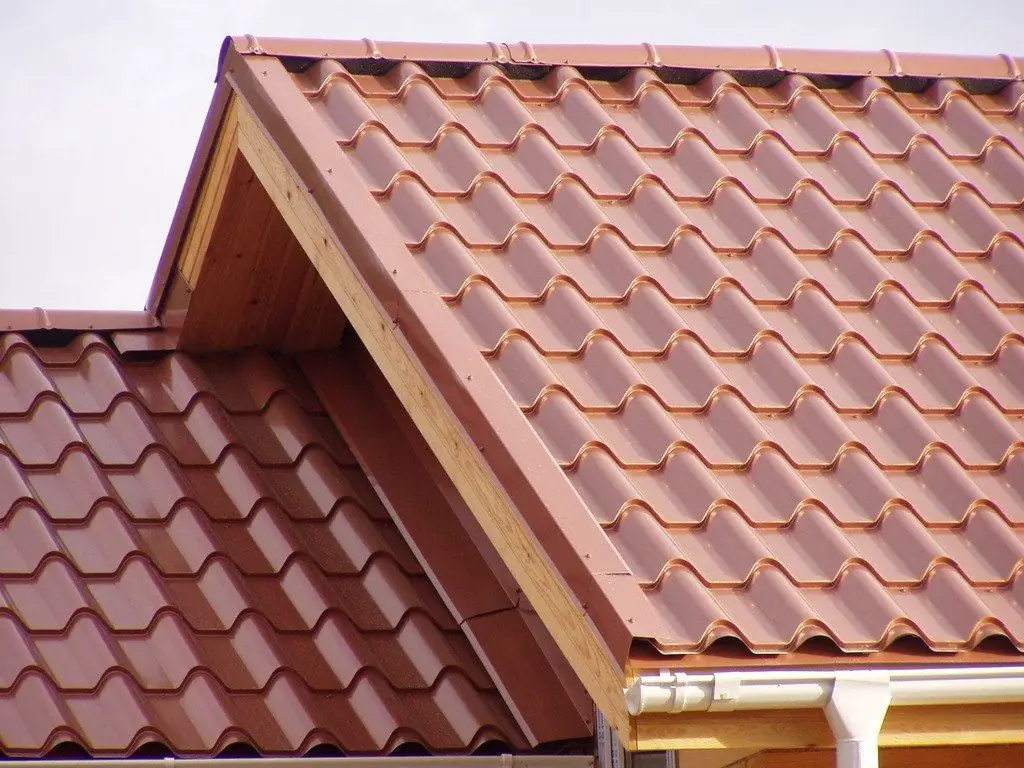
Methods and materials for the repair of metal roofing. What tool is needed and step-by-step instructions for eliminating roof breakages
Repair Of A Soft Roof, Including A Description Of Its Main Stages, As Well As Material And Tools For Work
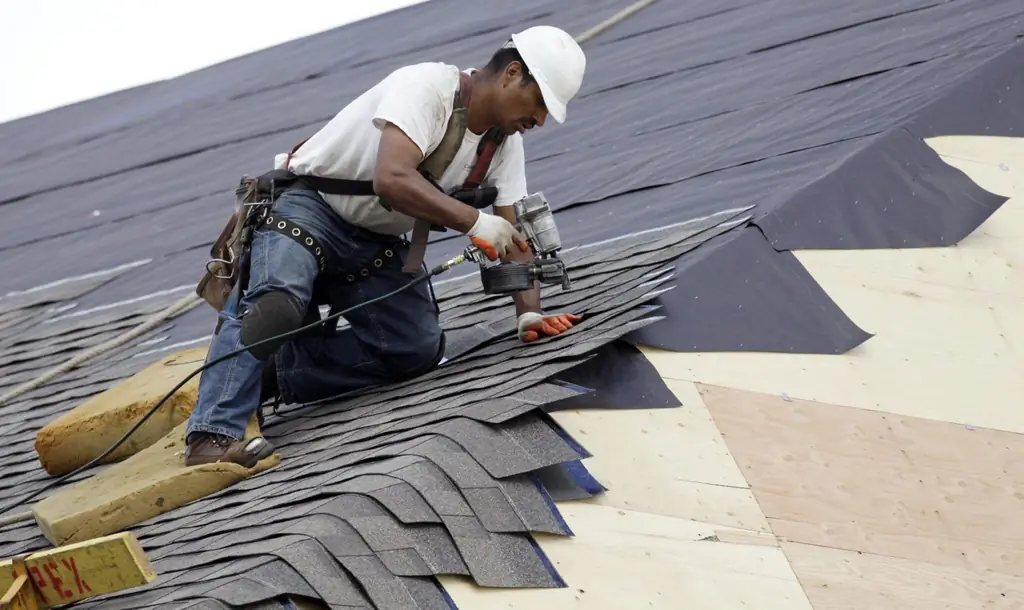
Diagnostics of the condition of the soft roof. Repair types and their main features. A brief overview of roofing materials and recommendations for their selection
Flat Roof Repair, Including A Description Of Its Main Stages, As Well As Material And Tools For Work
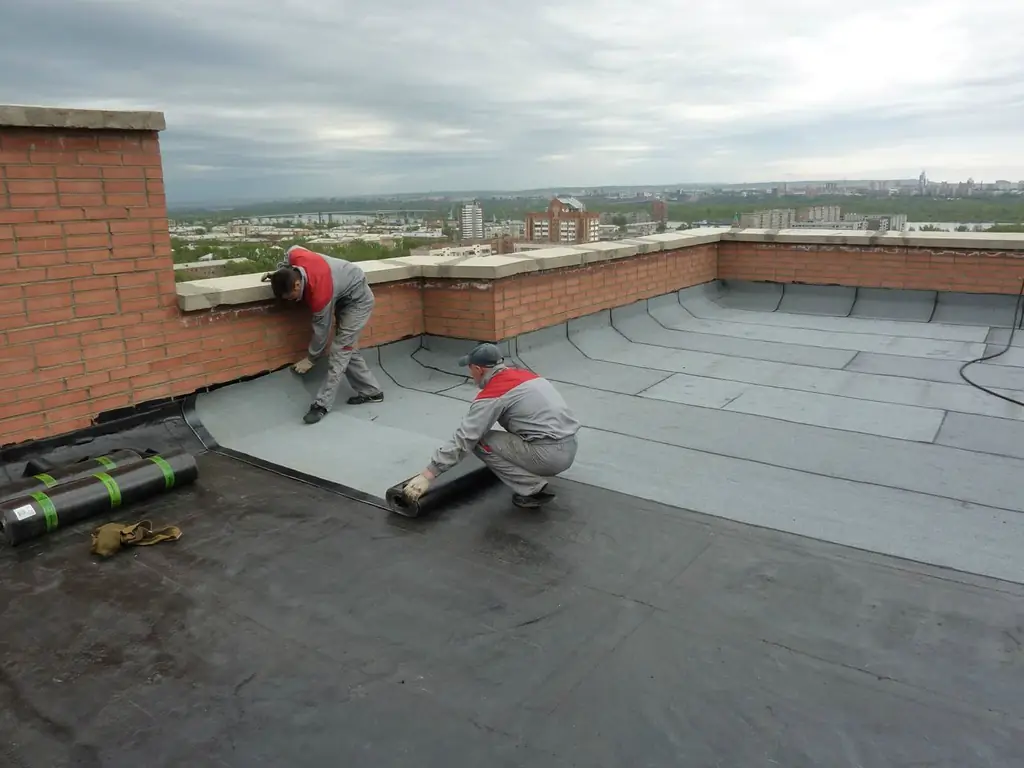
A brief description of the types of flat roof repair. Recommendations for the selection of roofing materials. Technology for eliminating various defects on flat roofs
Roof Repair, Including Its Various Types With A Description Of The Main Stages Of Work
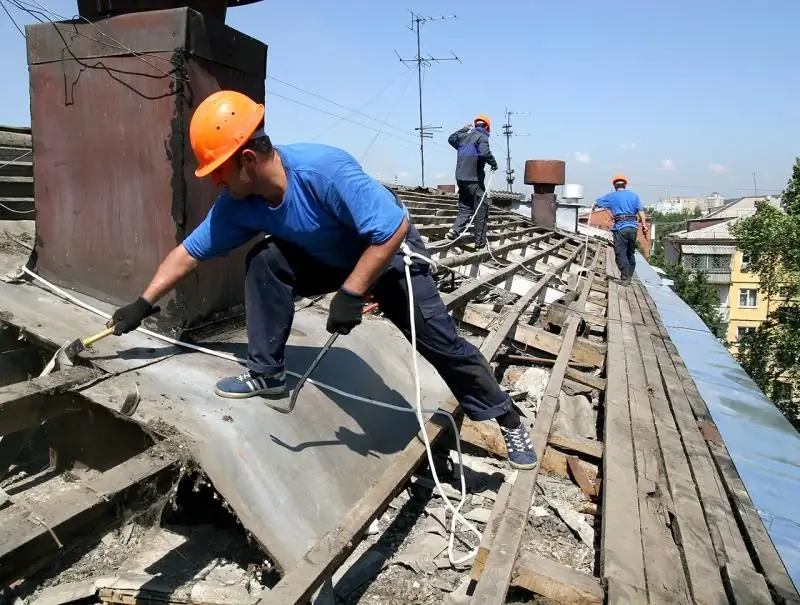
Features of various types of roofing pie repair. Required materials and tools. Step-by-step technology for repairing the main types of roofing
Rolled Roof Repair, Including A Description Of Its Main Stages, As Well As Material And Tools For Work

The main types of repair work. Preparation for work and general safety precautions. Step-by-step instructions for performing major and current repairs
